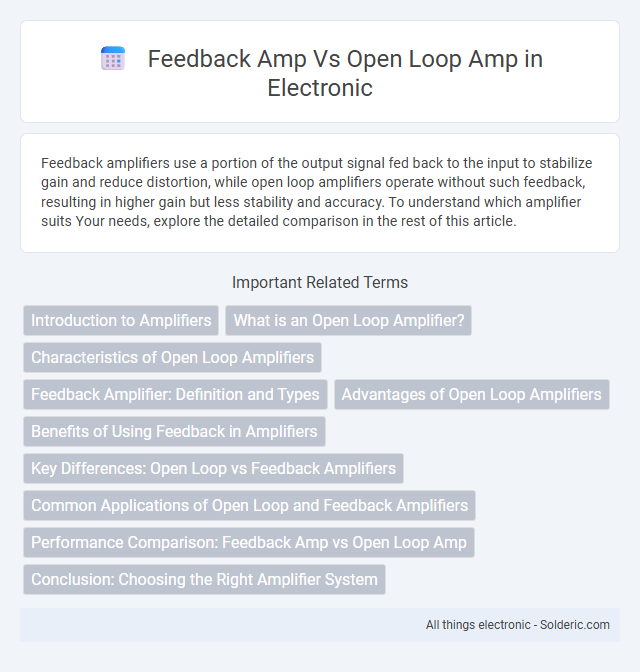Feedback amplifiers use a portion of the output signal fed back to the input to stabilize gain and reduce distortion, while open loop amplifiers operate without such feedback, resulting in higher gain but less stability and accuracy. To understand which amplifier suits Your needs, explore the detailed comparison in the rest of this article.
Comparison Table
| Feature | Feedback Amplifier | Open Loop Amplifier |
|---|---|---|
| Gain Stability | High stability due to feedback | Low stability, gain varies with conditions |
| Gain Value | Precise and controlled gain | Very high but uncontrolled gain |
| Distortion | Reduced distortion via feedback | Higher distortion levels |
| Bandwidth | Wider bandwidth due to feedback | Narrow bandwidth |
| Noise | Lower noise levels | Higher noise levels |
| Complexity | More complex circuit design | Simple circuit design |
| Usage | Used in precision amplification | Used in basic amplification |
Introduction to Amplifiers
Amplifiers are electronic devices that increase the amplitude of electrical signals, classified mainly into feedback amplifiers and open-loop amplifiers based on their circuit configurations. Feedback amplifiers utilize a portion of the output signal fed back to the input to stabilize gain and improve linearity, while open-loop amplifiers operate without feedback, providing higher gain but with less stability and more distortion. Understanding these amplifier types is essential for designing circuits in audio systems, communication devices, and signal processing applications.
What is an Open Loop Amplifier?
An open loop amplifier is an operational amplifier configured without any feedback network, resulting in a very high voltage gain typically exceeding 100,000. It amplifies the difference between its input terminals without stabilizing the output, making it highly sensitive to input variations and prone to saturation. Open loop amplifiers are mainly used in comparator circuits, where precise gain control is less critical than detecting voltage level changes.
Characteristics of Open Loop Amplifiers
Open loop amplifiers exhibit very high gain but lack stability and accuracy due to the absence of feedback mechanisms, resulting in significant distortion and sensitivity to component variations. Their output depends solely on the input signal amplified by the inherent gain, making them unsuitable for precise amplification tasks. You should consider their simplicity and high gain when designing circuits where exact control over gain is not critical.
Feedback Amplifier: Definition and Types
A feedback amplifier is an electronic amplifier that feeds a portion of its output signal back to its input to control its overall gain and improve stability, bandwidth, and linearity. Common types include voltage feedback amplifiers, which return voltage signals, and current feedback amplifiers, which use current signals, each optimized for specific performance characteristics such as speed or noise reduction. These amplifiers are essential in precision applications like audio processing, instrumentation, and control systems due to their enhanced accuracy and predictable behavior.
Advantages of Open Loop Amplifiers
Open loop amplifiers offer advantages such as higher gain since they do not rely on feedback networks that can reduce amplitude. They exhibit faster response times due to the absence of feedback-induced phase shifts, making them suitable for high-frequency applications. Additionally, open loop designs are simpler and consume less power, which benefits low-complexity, power-sensitive devices.
Benefits of Using Feedback in Amplifiers
Using feedback in amplifiers improves stability by reducing gain variations caused by temperature changes and component tolerances. Feedback lowers distortion and noise, resulting in higher fidelity and cleaner signal amplification. This technique also extends bandwidth and allows precise control of gain, enhancing overall amplifier performance.
Key Differences: Open Loop vs Feedback Amplifiers
Open loop amplifiers operate without signal feedback, resulting in high gain but less stability and precision, making them suitable for applications where exact control is unnecessary. Feedback amplifiers incorporate a portion of the output signal back into the input, improving linearity, reducing distortion, and enhancing bandwidth and stability. Understanding these key differences helps you select the right amplifier type based on performance requirements and control needs.
Common Applications of Open Loop and Feedback Amplifiers
Open loop amplifiers are commonly used in sensor signal conditioning and instrumentation where high gain without phase stability is acceptable, such as photodiode amplifiers and small-signal transducers. Feedback amplifiers dominate applications requiring precise gain control, low distortion, and improved bandwidth, including audio amplifiers, operational amplifiers in analog computing, and active filters. The use of feedback loops also enhances linearity and stability, making them essential in control systems and communication circuits.
Performance Comparison: Feedback Amp vs Open Loop Amp
Feedback amplifiers exhibit superior performance in terms of gain stability, linearity, and bandwidth compared to open loop amplifiers, owing to the negative feedback mechanism that minimizes distortion and reduces sensitivity to component variations. Open loop amplifiers provide higher raw gain but suffer from nonlinearities and susceptibility to parameter changes, leading to greater distortion and less predictable operation. The use of feedback significantly enhances accuracy and overall signal fidelity, making feedback amplifiers the preferred choice in precision applications.
Conclusion: Choosing the Right Amplifier System
Choosing the right amplifier system depends on the specific application requirements for performance and stability; feedback amplifiers offer improved linearity, reduced distortion, and controlled gain, making them suitable for precision audio and instrumentation. Open loop amplifiers provide higher gain but with less stability and greater distortion, ideal for applications where maximum amplification of weak signals is necessary without stringent accuracy demands. Assessing factors such as bandwidth, noise tolerance, and design complexity helps determine whether a feedback or open loop amplifier best meets your system's objectives.
Feedback amp vs Open loop amp Infographic

 solderic.com
solderic.com